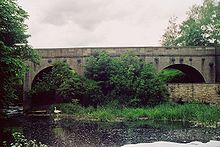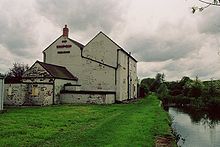- Mansfield and Pinxton Railway
-
The Mansfield and Pinxton Railway was an early horse-drawn railway company in the United Kingdom, constructed in 1819 to transport coal between Mansfield and the head of the Pinxton branch of the Cromford Canal and thence by the Erewash Valley and the Trent to Leicester. Its importance lies in its influence on later railway building in the area, particularly the development of the Midland Counties Railway.
Contents
History
For many years, as in other parts of the country, Nottinghamshire quarry owners and miners had built wagonways to transport heavy goods. As larger projects were proposed, usually where the terrain made canal building impracticable, outside investment was required. Railway promoters became required to justify their plans and their likely viability before Parliament, as had been the case with canal building. Thus the Mansfield and Pinxton became the first railway in the East Midlands to be incorporated by Act of Parliament, in 1817.
Although the idea of the railway was mooted in 1811 there was considerable delay while a decision was taken as to what form it should take. Wagonways had developed into steel plateways, for which Benjamin Outram of the Butterley Company had gained considerable expertise. His partner, William Jessop, had however, pioneered the use of fish-bellied iron edge rails on the earlier Charnwood Forest Canal. In the end, his son Josiah, as engineer, used the latter.
Opening
The first load of coal arrived in Mansfield on April 13, 1819 and was taken to the marketplace to be ceremoniously burnt. Costing less than £25,000 to build, its original purpose had been to carry stone and lime from Mansfield, but it soon proved its worth carrying coal. It facilitated the opening of a number of new pits, for which branches were provided, along with a branch to the Butterley Company's works at Codnor Park. Another important cargo was moulding sand from Mansfield. Although, in the long term the railway would bring prosperity to Mansfield, it initially caused a great deal of distress to the horse dealers and wagon masters, many of whom lost their livelihood. In 1832 a coach was introduced each Thursday (the market day) for second and third class passengers from the Boat Inn at Pinxton Wharf.
Lack of transport had for a century put the Leicestershire miners at a disadvantage, but in 1832, they opened the Leicester and Swannington Railway. The Nottinghamshire miners, therefore proposed extending the M & P.R. via the Erewash Valley, to Leicester, but found it difficult to raise finance, being still well-served by the canal network. Meanwhile there were a number of ambitious railways schemes in the air. In the early 1830s the M & P.R. had been approached by the proposed London Northern Railway, and in 1833 another abortive venture, the Midland Grand Junction Railway, proposed to take it over. The M & P.R. owners therefore decided to promote a connection between Nottingham, Leicester and Derby, to be called the Midland Counties Railway.
Take-over
Investment was still very slow, until finance was obtained from Lancashire and Yorkshire financiers. They, however, were deeply committed to the North Midland Railway and refused to finance the connection to the M & P.R., particularly an associated proposal to extend to Chesterfield. Accordingly, the Midland Counties Railway was built without the connection to the M & P.R.
The line was finally taken over by the newly-formed Midland Railway in1847. However railway technology had moved on and the track needed to be relaid. In 1847 a line was built from Long Eaton to Pye Bridge, near Ironville. Another line was built in 1848 from Nottingham to Kirkby, with the Midland providing a horse-drawn coach from there to Mansfield, since the old rails were not strong enough for a steam locomotive. In 1849 the line was relaid from Mansfield and extended to Pye Bridge.
Several parts of the old lines had been winding with gentle gradients for the horses, which also had a braking effect in the downward direction with the wheel flanges pressing against the rails. Most of these curves were realigned and there were one or two changes in succeeding years. Most notably in 1871 a deviation was made which avoided Jessup's Kings Mill Viaduct and in 1892 a deviation to join the line from Nottingham south of Kirkby-in-Ashfield involving a gradient of 1 in 45.
The railway today
Much of the line still exists, though with the contraction of the coal industry at the end of the twentieth century it sees little traffic. Mansfield station was closed in 1965 but remained standing and was restored as a Grade 2 listed building to serve the Robin Hood Line in 2001.
References
- Birks, J.A. and Coxon, P. (1949) "The Mansfield and Pinxton Railway", Railway Magazine, 95 (582: July/August), p. 224–233
- Hughes, A: A thesis on the Mansfield and Pinxton Railway - in Sutton-in-Ashfield library, Mansfield Library and Melbourne library Australia
- Riden, P. (1990) The Butterley Company 1790-1830, Chesterfield : Derbyshire Record Society, 16, 2nd Ed., ISBN 0-946324-12-3
- Stevenson, P.S. (Ed.) (1989) The Midland Counties Railway, Mold : Railway and Canal Historical Society, ISBN 0-901461-11-3
- Vanags, J. (2001) The Mansfield and Pinxton Railway, Old Mansfield Society, ISBN 0-9517948-5-X
External links
- "Picture the Past" Mansfield Railway Station
- "Picture the Past" Mansfield Station Front
- "Picture the Past" Platform and Waiting Rooms
- [1] Extract from Mansfield and Pinxton Railway - J Vanags
Categories:- Grade II listed buildings in Nottinghamshire
- Early British railway companies
- Midland Railway
- Rail transport in Nottinghamshire
- History of Nottinghamshire
- Railway companies established in 1817
- Railway lines opened in 1819
- Railway companies disestablished in 1847
- Horse-drawn railways
Wikimedia Foundation. 2010.


